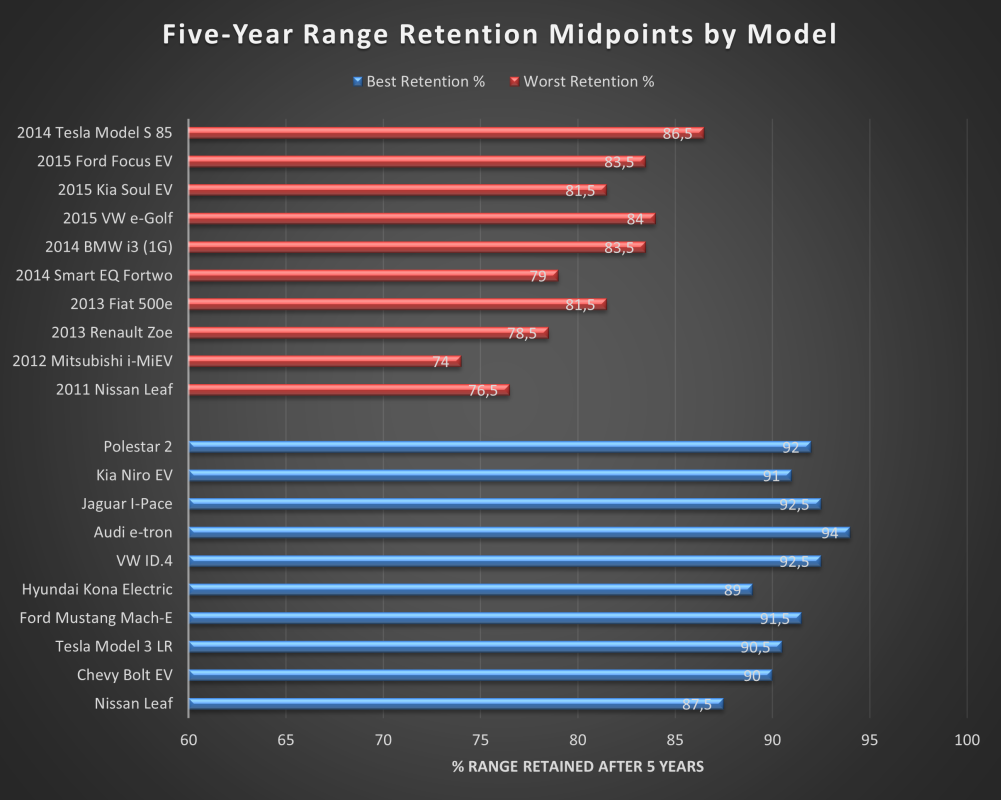“Roll up to a tailgate in 2025 and your five-year-old EV still reads 280 miles on the dash — no spring in your step lost”. Today’s mainstream packs fade only 1.8% — about a 9% total drop in five years — thanks to liquid cooling, smarter BMS balancing and tougher cell chemistries. How is your battery range after 5 years? Find your car below.

The Great Leveling
Not everyone has kept up in this great levelling, though. Let’s talk about the winners and losers.
Back in EV’s early days, five-year retention ranged from under 70% for early Leafs to over 90% on rare liquid-cooled prototypes. Now, the top 10 mainstream EVs all cluster between 87% and 94%. Geotab’s analysis of 5,000+ EVs nails average fade at 1.8% — down from 2.3% half a decade ago. That uniformity isn’t magic; it’s the payoff of liquid-cooling loops, advanced cell balancing, and the slow march toward LFP and nickel-rich chemistries.
Heroes vs. Has-Beens
At the summit, Audi’s e-tron and the Jaguar I-Pace boast midpoints above 92%, proof that premium packs and active thermal management pay dividends. Tesla’s Model 3, Ford’s Mach-E and VW’s ID.4 aren’t far behind — hovering near 91–92% retention. Entry-level contenders like the Bolt EV and Kona Electric still muster around 89–90%, a solid showing given their price points. Contrast that with the Worst 10: early Leafs, i-MiEVs and first-gen conversions now languish in the mid-70s to low-80s, victims of air-cooled packs and minimal cell-monitoring.
Expect that second-hand EV to have lost a good deal of its battery range; don’t let the salesman argue that the battery holds its original range.

Real-World Rituals
Veteran EV owners treat charging like pit stops: maintain State of Charge between 20–80%, lean on Level 2 overnight, and dodge DC-fast-charge binges. That routine can reclaim 2–3% pack health over five years — enough to claw back 10–20 miles on your daily commute. Nissan’s warranty—guaranteeing 80% capacity at five years — sets the floor; real-world LeafSpy data often show high-80s retention in mild climates.
Beyond the Numbers
With the big thermal fixes in place, the next frontier is marginal: who resists 120 °F summer blasts? Which chemistry outlives the others at decade-old mileages? And how much will solid-state and silicon-enhanced cells narrow that remaining 1–2% gap?
Related: 5 Game-Changing Batteries That Will Change Your Life
Bottom Line
Battery fade has gone from horror story to resolved footnote. Mainstream EVs now play in a tight pack — over 90% range left after five years — while yesterday’s laggards fall far behind. When you shop your next Leaf, Bolt, Mach-E or Model 3, trust the data: charge smart, drive hard and let real-world numbers — not fear-mongering headlines — steer your choice.